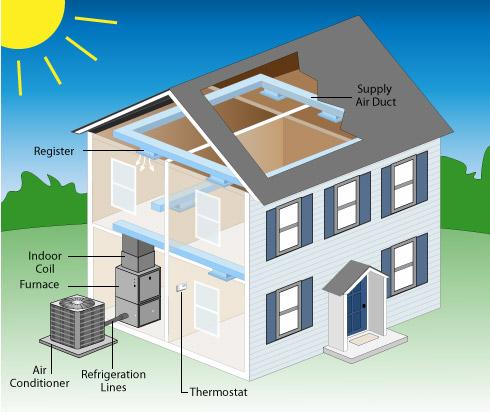Air Conditioning System
Central Air Conditioning
To cool your home, air conditioners use a chemical known as a refrigerant to transfer heat to the outside air. To perform this function, an air conditioning system has three main mechanical components: a compressor, a condenser and an evaporator coil. These components are responsible for converting the refrigerant from a gas to a liquid and back again.

The cooling cycle begins when the refrigerant arrives at the compressor as a cool, low-pressure gas. The compressor squeezes the refrigerant and packs the molecule of the refrigerant closer together, causing them to increase in temperature. The refrigerant leaves the compressor as a hot, high-pressure gas and flows into the condenser. In the condensing coil, the refrigerant releases its heat. A fan draws outdoor air in through louvers surrounding the outdoor cabinet and blows air across the hot coil. As the air blows across the coil, it transfers the heat to the outside air and cools the refrigerant inside the coil.
When the refrigerant leaves the condenser coil, its temperature is much cooler and it has changed from a gas to a liquid under high pressure. The refrigerant then flows indoors through tubing and passes through a small opening in the expansion valve. In this valve, the refrigerant expands and the liquid's pressure drops and becomes a low-temperature, low-pressure liquid that flows into the evaporator coil where it evaporates absorbing heat from the return air blown over the indoor coil by a fan. At the same time, moisture in the air is removed as it condenses on the indoor coil. Humidity removed from the air, as it makes contact with the indoor coil, is collected in a pan at the bottom of the coil and flows to a drain.
Refrigerant leaving the evaporator then returns to the compressor and the cycle continues. When the room reaches the temperature set on the thermostat, the air conditioner turns off. As the room warms up, the thermostat turns the air conditioner back on.
Types of Central Air Conditioning Systems
Homeowners typically have a choice between two central air conditioner system configurations: a split system or a package system. A split system includes an outdoor metal cabinet, which contains the condenser and compressor, and an indoor cabinet that contains the evaporator coil. The outdoor cabinet is located next to the home and the evaporator coil is located inside the home, above or near the air handling unit (furnace or blower). The indoor components may be located in a crawlspace, basement, attic or closet. In split systems, the outdoor and indoor units must be properly matched to achieve the rated efficiency.
In a single-package system, all of the mechanical parts are housed in one cabinet, typically located outside the house.